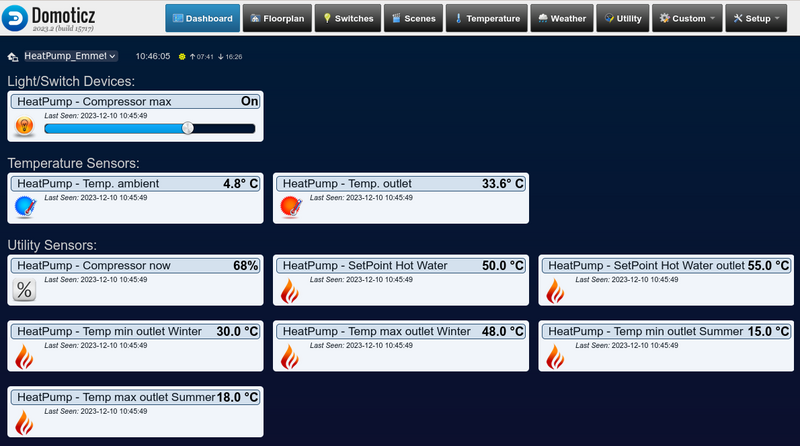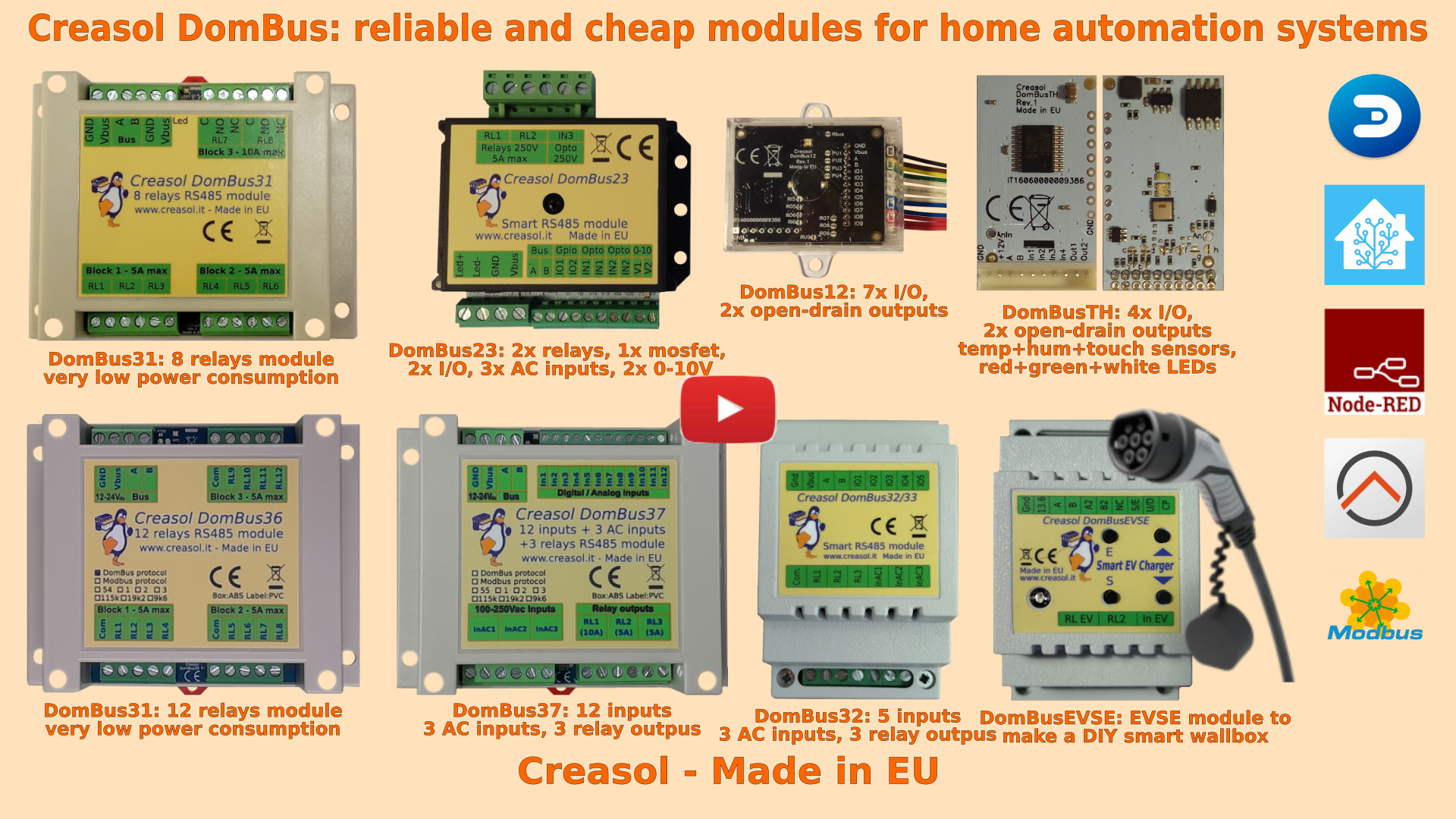This is a plugin for the free open-source Domoticz home automation system that read and write some parameters from/to the Emmeti Mirai heat pump by Modbus connection (RS485 serial connection).
Emmeti Mirai heat pumps have a RS485 port designed to communicate by Modbus protocol with Emmeti Febos-HP device which read the power from the electricity grid and set the maximum compressor frequency (power) that the heat pump can use to improve own-consumption.
Who already have a domotic system and photovoltaic on the roof, do not need to reinvent the wheel installing Febos-HP: they can use an automation (LUA script?) that controls the heat pump in this way:
- increase the heat pump power consumption in case that energy is exported to the grid (solar photovoltaic is producing more than house usage), increasing the self-consumption
- in the Winter, act as a smart thermostat that increases the room temperature setpoint (overheating) in case of excess photovoltaic production, to get the heat pump off in the evening/night
- in the Summer, activates the heat pump only if there is enough solar photovoltaic production, consuming Zero Watt from the electrical grid
A LUA script for Domoticz that controls the Emmeti Mirai heat pump is available in github.
Anyway, using this plugin is possible to read and change main heat pump parameters manually.
Plugin is tested using Emmeti Mirai SMI EH1018DC with firmware Rev.C: please note that different heat pump firmware version lead to different register address.
This software comes with absolute no warranty. Please check the manual to verify that modbus address registers meets the plugin configuration (check next section).
This plugin can be installed from Python Plugin Manager or Python Plugins Manager which also permit to update plugin easily or automatically.
Alternatively, it's possible to give the following commands from the linux shell:
cd ~/domoticz/plugins
git clone https://github.com/CreasolTech/domoticz-emmeti-mirai
Then, in the future, to update the plugin it's possible to simply type
cd ~/domoticz/plugins/domoticz-emmeti-mirai
git pull
Used python modules: minimalmodbus -> http://minimalmodbus.readthedocs.io
Please edit the plugin.py file and check that register address of your heat pump are exactly the ones specified in the configuration (second field in the parameter list).
Restart Domoticz, then go to Setup -> Hardware and add the Emmeti Mirai heat pump plugin, specifying a name for that hardware and the serial port to connect heat pump.
Plugin can be easily translate in other languages: just add the language code to LANGS variable, and add a field to each device with the translated name of device. Please send a copy of the plugin.py file to linux at creasol dot it
Many thanks to:
- Patrick Hamers, who developed the plugin for SPRSUN heat pump
Below a list of modules, produced in Italy by Creasol, designed for high reliability and optimized for very very low power consumption.
Our industrial and home automation modules are designed to be
- very low power ⇒ 10÷15mW with relays OFF
- reliable ⇒ no disconnections
- wired network (bus) ⇒ no radiofrequency interference, no battery to replace
Modules are available in two versions:
- with DomBus proprietary protocol, suitable for every type of DomBus modules, working with Domoticz by using the Creasol DomBus plugin, and Home Assistant, OpenHAB, Node-RED ... by using the DomBusGateway software, a DomBus 2 MQTT-AutoDiscovery interface
- with Modbus standard protocol, suitable for relays modules, EVSE and Dual Axis solar tracker, working with almost any building automation system supporting Modbus
What version is the best? DomBus version, because:
Modbus is a standard protocol Master/Slave: the controller must poll each module to get its status, so it's not suitable to manage inputs and counters that change frequently, but can be used to manage relay outputs or read inputs status every 2-5s
DomBus is a proprietary multi-master protocol where each module is able to initiate the communication with the master to notify, for example, an input change, with a short latency (<100ms) that permits to manage alarm sensors in a reliable way. Also, DomBus supports the so-called DCMD, commands exchanged between modules as KNX does, so it's possible to program simple automations that work between modules even if the domotic controller is OFF (for example, short pulse on button to toggle a light ON/OFF, 1s pulse to open the garage door, 2s pulse to turn OFF some lights, ...)
Store website - Information website
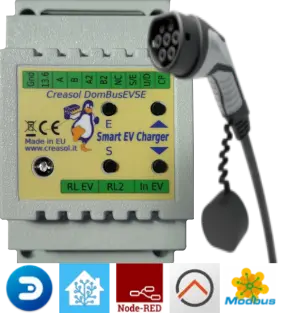
- Single-phase and three-phase, up to 32A (8kW or 22kW)
- Needs external contactor, RCCB (protection) and EV cable
- Optional power meter to measure charging power, energy, voltage and power factor
- Optional power meter to measure the power usage from the grid (not needed if already exists)
- Two max grid power thresholds can be programmed: for example, in Italy who have 6kW contractual power can drain from the grid Max (6* 1.27)=7.6kW for max 90 minutes followed by (6* 1.1)=6.6kW for another 90 minutes: in this case the EVSE module can drain ALL available power when programmed to charge at 100% minimizing the charge time and increasing the charging efficiency.
- Works without the domotic controller (stand-alone mode), and can also work in managed mode, with an automation in the home automation system setting the charging current
DomBusTH - Compact board to be placed on a blank cover, with temperature and humidity sensor and RGW LEDs
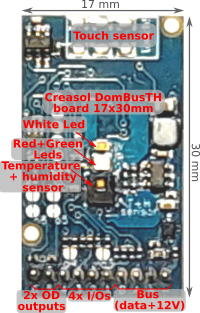
Includes:
- temperature and relative humidity sensor
- red, green and white LEDs
- 4 I/Os configurable as analog or digital inputs, pushbuttons, counters (water, gas, S0 energy, ...), NTC temperature and ultrasonic distance sensors
- 2 ports are configured by default as open-drain output and can drive up to 200mA led strip (with dimming function) or can be connected to the external module DomRelay2 to control 2 relays; they can also be configured as analog/digital inputs, pushbuttons and distance sensors.
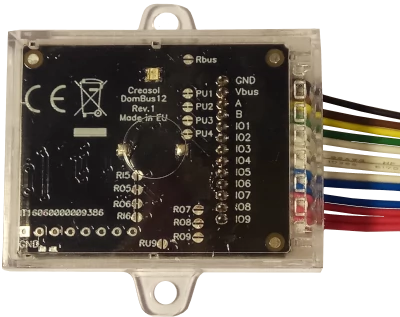
- analog/digital inputs
- pushbutton and UP/DOWN pushbutton
- counters (water, gas, S0 energy, ...)
- NTC temperature and ultrasonic distance sensors
- 2 ports are configured by default as open-drain output and can drive up to 200mA led strip (with dimming function) or can be connected to the external module DomRelay2 to control 2 relays.
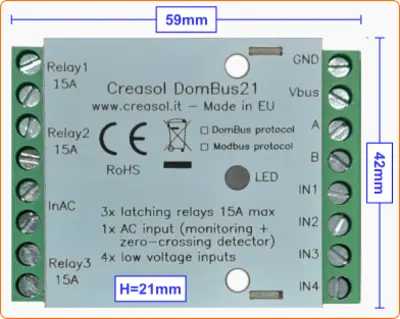
- 3x latching relays SPST, max current 15A (3kW): no power consumption when relays are On or Off!
- 1x 230V AC opto-isolated input to detect 230V and power outage, with zero-detection to switch relays/loads minimizing in-rush current
- 4x I/O lines, configurable as analog/digital inputs, temperature/distance sensor, counter, meter, ...
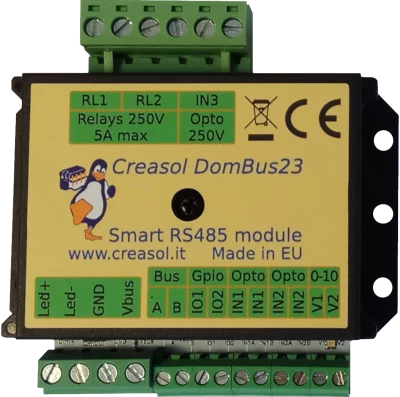
- 2x relays SPST 5A
- 1x 10A 30V mosfet (led stripe dimming)
- 2x 0-10V analog output: each one can be configured as open-drain output to control external relay
- 2x I/O lines, configurable as analog/digital inputs, temperature/distance sensor, counter, ...
- 2x low voltage AC/DC opto-isolated inputs, 9-40V
- 1x 230V AC opto-isolated input

- 6x relays SPST 5A
- 2x relays STDT 10A
- Only 15mW power consumption with all relays OFF
- Only 600mW power consumption with all 8 relays ON !!
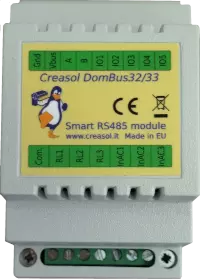
- 3x relays SPST 5A
- 3x 115/230Vac optoisolated inputs
- Single common for relays and AC inputs
- 5x general purpose I/O, each one configurable as analog/digital inputs, pushbutton, counter, temperature and distance sensor.

- 3x relays SPST 5A
- 3x 115/230Vac optoisolated inputs
- Single common for relays and AC inputs
- 5x general purpose I/O, each one configurable as analog/digital inputs, pushbutton, counter, temperature and distance sensor.
Each relay can toggle the existing step-relay, switching the light On/Off. The optoisolator monitors the light status. The 5 I/Os can be connected to pushbuttons to activate or deactivate one or all lights.

- 12x relays SPST 5A
- Relays are grouped in 3 blocks, with a single common per block, for easier wiring
- Only 12mW power consumption with all relays OFF
- Only 750mW power consumption with all 12 relays ON !!
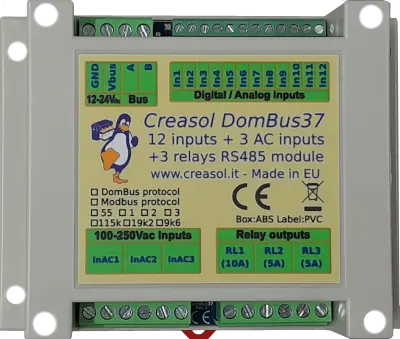
- 12x low voltage inputs (analog/digital inputs, buttons, alarm sensors, balanced double/triple biased alarm sensors, counters, meters, temperature and distance sensors, ...)
- 3x 115/230Vac optoisolated inputs
- 2x relays SPST 5A
- 1x relay SPST 10A
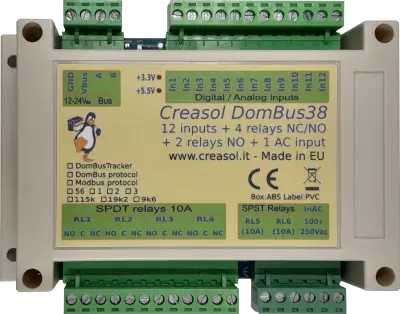
- 12x low voltage inputs (analog/digital inputs, buttons, alarm sensors, balanced double/triple biased alarm sensors, counters, meters, temperature and distance sensors, ...)
- 1x 115/230Vac optoisolated input to detect power outage and for zero-crossing detection (to switch relays minimizing the in-rush current)
- 4x relays SPDT 10A (with Normally Open and Normally Closed contacts)
- 2x relays SPST 10A (with only Normally Open contacts)
DomBusTracker - Dual axis sun tracker controller working with Domoticz, Home Assistant, Node-RED, Modbus, ... and also working in standalone with no external controllers
Module that check a deep-hole sun sensor to detect the direction of maximal sun radiation, working also in case of cloudy weather.
- Controls two external actuators/motors (linear or not) to move motors to reach the best tilt / elevation and azimuth position to optimize photovoltaic production.
- Check current through the motors to detect internal limit switch (useful for linear actuators) and find where the tracker reach the final/initial position.
- Works autonomously (stand-alone), without any home automation system controller, but also can be connected to a home automation system using Domoticz, Home Assistant, NodeRED, OpenHAB, and other systems by using the DomBusGateway software (that converts DomBus protocol to MQTT AutoDiscovery), or with other systems by using DomBusTracker with Modbus firmware.
- Wire connection (RS485) to the domotic controller for the best reliability.

- 2x SPST relays 5A (Normally Open contact)
- Overvoltage protection (for inductive loads, like motors)
- Overcurrent protection (for capacitive laods, like AC/DC power supply, LED bulbs, ...)
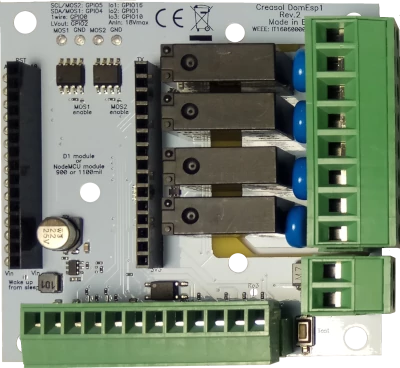
- 9÷24V power supply input, with high efficiency DC/DC regulator with 5V output
- 4x SPST relays 5A with overvoltage protection (varistor)
- 2x mosfet outputs (max 30V, 10A) for LED dimming or other DC loads
- 1x I²C interface for sensors, extended I/Os and more)
- 1x OneWire interface (DS18B20 or other 1wire sensors/devices)
